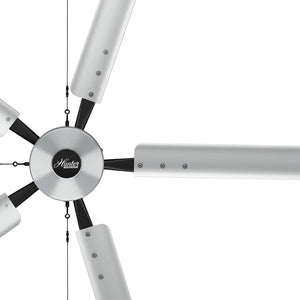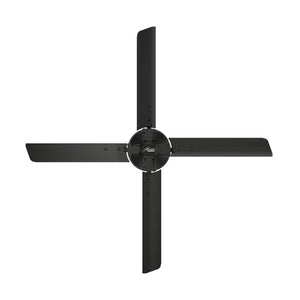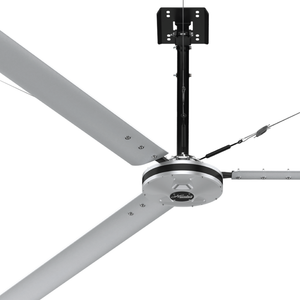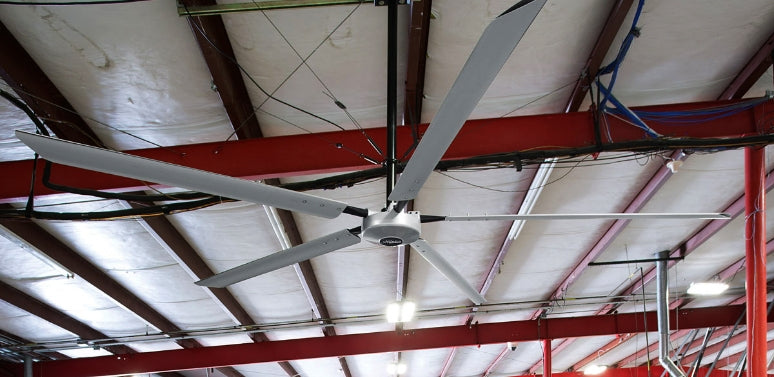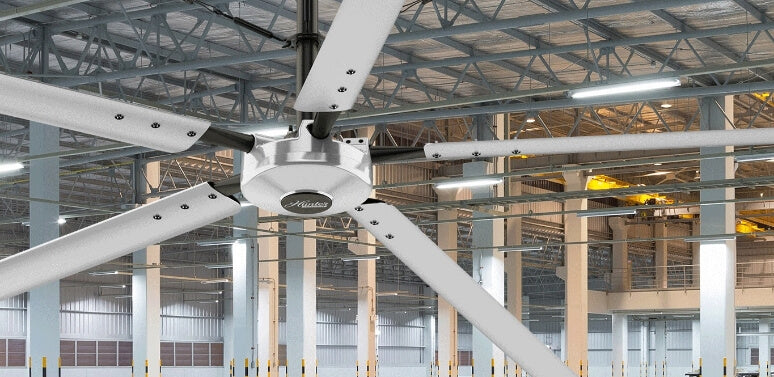HVLS Fans Buying Guide: How to Choose the Right Industrial Ceiling Fan

TABLE OF CONTENTS
Getting the Right HVLS Industrial Ceiling Fans ROI & Cost Justification Hybrid Solutions Industry-Specific Applications Frequently Asked Questions About Buying HVLS FansIn a warehouse, manufacturing plant, or large commercial facility, airflow involves more than just comfort; it encompasses safety, productivity, and cost control. That's where HVLS (High-Volume, Low-Speed) fans come in. These large industrial ceiling fans range from 7 to 24 feet in diameter. Unlike residential fans that only stir the air in one spot, HVLS fans move massive amounts of air efficiently across wide spaces.
In the summer, that means a perceived cooling effect of up to 10°F and relief from heat stress. In the winter, our HVLS fans help with destratification, redistributing trapped warm air from the ceiling back down to the floor, helping reduce HVAC runtimes and potentially lowering energy costs.
This HVLS Fans Buying Guide will walk you through what to look for, from sizing and installation requirements to ROI and industry-specific applications, so you can make a confident investment in comfort and efficiency.
Getting the Right HVLS Industrial Ceiling Fans
To choose the right HVLS fan, you need to match the fan to your facility's unique needs. From ceiling height and square footage to motor type, controls, and installation requirements, a few key factors will guide your decision. Here's what to look at before you buy.
Assess Your Space
The first step is understanding your facility. Ceiling height, total square footage, and any airflow obstacles (racking, machinery, mezzanines) all affect performance. HVLS fans are best suited for buildings with ceiling heights of at least 20 feet, though smaller options exist. As a rule of thumb, fans must hang at least 10 feet above the floor and at least 25% of the fan diameter from the ceiling. Allow a minimum of 2 feet of clearance from lighting fixtures and 5 feet from walkways or mezzanines.
Determine Fan Size & Quantity
Hunter Industrial's HVLS fans range in diameter from 7 feet to 24 feet. Even the smaller models, like our XP HVLS fan, a single fan can move air across 1,200+ square feet. At the other end of the spectrum, a 24-foot industrial ceiling fan like the Titan HVLS fan covers up to 22,500 square feet with a single fan. For larger facilities, multiple fans may be required to ensure consistent airflow. A general guideline: one 24-foot fan can replace dozens of small warehouse fans, helping to reduce clutter and energy use.
Select Drive Type & Blades
Gear-drive motors, still used by some manufacturers, can be noisy and prone to oil leaks. Hunter Industrial's Direct Drive Motors eliminate those risks while reducing maintenance needs. Blade construction also matters: our blades are designed with aircraft-grade aluminum with redundant safety features allowing for both durability and peace of mind.
Plan for Controls & Integration
Traditional fans operate with simple on/off controls, but many facilities benefit from more advanced options. Our intuitive digital fan network controllers allow zoning by area, variable speed adjustments, or integration into existing building automation systems. This level of control supports more efficient, tailored airflow management, which is essential in warehouses or manufacturing facilities with varied workflows.
Evaluate Installation Needs
Structural support is critical. HVLS fans must be mounted to sturdy materials such as I-beams, Unistrut, purlin structures, or glulam beams that are capable of holding roughly twice the maximum hanging weight of the fan. Electrical requirements should also be considered.
Pro Tip: For best results, sign up for Hunter Industrial Precision Services™ and let our certified professionals install and care for your Hunter Industrial HVLS fans.
ROI & Cost Justification

For most facilities, the case for HVLS fans includes a return on investment. By improving airflow, these large industrial fans help reduce the workload on HVAC systems, potentially cutting energy use significantly. That can translate into lower utility bills compared to relying solely on HVAC or rows of smaller fans.
The benefits extend beyond energy savings. In hot conditions, HVLS fans create a perceived cooling effect of up to 10 degrees, helping reduce heat stress and fatigue on the floor. In winter, destratification helps prevent wasted heat at the ceiling from HVACs, allowing you to get the most from every dollar spent on heating.
When evaluating HVLS fan ROI, consider both direct cost savings and the ripple effects on your operation. Comfort leads to efficiency, efficiency leads to productivity, and productivity drives profitability. It's a long-term investment that pays off in multiple ways.
Hybrid Solutions
While HVLS fans can anchor airflow strategies in large facilities, they aren't the only solution. Many warehouses and manufacturing plants see the best results by pairing HVLS fans with other types of industrial and commercial ceiling fans to address specific zones or challenges.
For example, loading docks often need extra air movement to combat frequent door openings, making wall-mounted, pedestal, drum fans, or other air circulators a smart complement. The Jan Fan Articulating Arm Mount is purpose-built for these environments, allowing 12", 18", 20", and 24" Jan Fans to be positioned precisely where airflow is needed most. Its adjustable design makes it ideal for dock and door settings, helping maintain comfort and reduce temperature fluctuations as trucks come and go.
In other areas, C-Channel Mounts offer a reliable, space-saving solution for securely attaching Jan Fans to overhead structures — perfect for warehouses, factories, and tight work zones. By elevating the fan, this mount improves circulation, frees up valuable floor space, and enhances safety by keeping equipment out of high-traffic areas. Both mounting options are built from heavy-duty materials for lasting durability and flexibility as facility layouts evolve.
EXPLORE OTHER CATEGORIES
Industry-Specific Applications
HVLS fans are used across a wide range of industries, but the benefits can look a little different depending on the space. Here's how various facilities put these large industrial fans to work.
- Warehouses & Distribution Centers: By replacing dozens of small warehouse fans with HVLS fans, you can reduce clutter, potentially lower energy use, and maintain a productive, more comfortable environment for employees and inventory.
- Manufacturing Plants & Factories: HVLS fans help improve airflow across large, open areas, helping to reduce hot spots and keep operations running smoothly.
- Agriculture & Barns: In dairy barns and other agricultural settings, HVLS fans help manage humidity, reduce heat stress, and keep animals comfortable and productive. We recommend the IP66 Fan Drive Enclosure for covered, outdoor facilities to help protect your HVLS fan.
- Gyms, Breweries, & Event Spaces: Large public spaces benefit from HVLS fans' ability to circulate air quietly and efficiently. By keeping customers comfortable, you're also supporting repeat business and longer visits.
- Aviation Hangars: HVLS fans help manage temperature swings and improve working conditions for crews on the ground.
Rely on Hunter Industrial for the Best HVLS Fans for Your Facility
Discover the difference HVLS fans can make. Hunter Industrial & Commercial has the experience, engineering, and support to help you choose the right solution. Explore our lineup of HVLS fans today or request a free quote to get started.
Frequently Asked Questions About Buying HVLS Fans
Below, we've addressed a few common questions about HVLS fans. Please contact us for more information.
How do I choose an HVLS fan?
Start by assessing your facility's size, ceiling height, and layout. Consider airflow obstacles, such as racking or machinery, and remember that you may need multiple units for complete coverage. Our HVLS Ceiling Fan Size Guide is an excellent resource to help you select a HVLS fan to maximize comfort and efficiency.
Yes, HVLS fans can provide both comfort and long-term ROI. They help reduce HVAC runtimes, lower energy costs, and improve working conditions. That's why understanding the ROI of your HVLS fan is so important.
Pricing depends on the HVLS fan diameter and control options you choose. Because every facility is different, Hunter Industrial provides a customized quote to ensure you get the right solution for your space. While the initial investment may be higher than smaller residential fans, the long-term savings and performance benefits make HVLS a cost-effective investment.
Despite their size, HVLS fans are surprisingly energy-efficient. A 24-foot model can often replace several smaller fans while still potentially lowering your energy costs. This efficiency is what makes HVLS fans such an effective strategy for energy-efficient warehouse airflow strategy.

 100% Secure Payments
100% Secure Payments